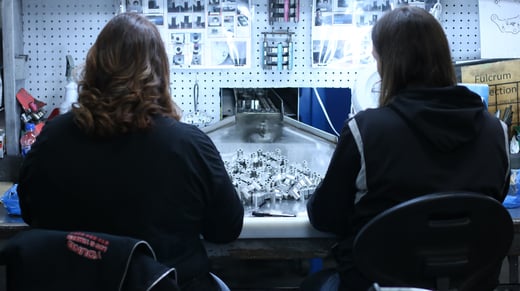Powder metallurgy manufacturers should always be working to stay ahead of the industries it serves.
For the customer, that means designing you a better process, developing better materials for you, or improving the technology that makes both happen. While 80% of the industry has been relying on nearly the same technology, processes, and materials, automotive and other OEM customers need something more.
Giving that “extra” has been our mission since 2001. Here’s a time-capsule look into how powder metallurgy processes have evolved at Horizon the last 2 decades, plus a sneak peek at how we’re working to move your product forward in the future.
Advances in the Powder Metallurgy Process: 2001 to Today
Have you been working with powder metallurgy (PM) companies stuck in that 80%? Was your opinion of powder metal formed 20+ years ago? You may have missed out on some great advances in powder metallurgy over the years.
In 2001 -- Horizon’s first year -- we were bare-bones too.
We had a few die set compaction presses capable of producing multiple-level parts. Our sintering furnaces were capable of producing temperatures of up to 2150°F.
But even in those early days, we spotted opportunities for customers to get more out of PM. This was accomplished in a few ways:
- Use of processes and unique materials that helped customers’ components surpass 7.3 g/cc density to improve performance
- These higher densities also improved performance for magnetic applications, through the use of sintered soft magnetics for applications like solenoids
- In ensuing years, we continued to add larger presses, up to 550 tons. Little by little, we’ve been able to make bigger components over the years. Today you can order a multilevel part up to 18 sq. in. in plainer area.
Like other powder metallurgy companies, we’ve evolved from mechanical presses to CNC (computer numerical control) presses. Today’s PM suppliers have much more control over the process and can produce parts to much tighter tolerances.
Did You Know Furnaces Can Get This Hot?
Things heated up when Abbott Furnace Co. approached us with a new sintering furnace design in 2005. A high-temperature furnace, which also featured a rapid cooling process, and it forever changed what was possible with sintering and heat treating powder metal at temperatures over 2300° F.
With Abbott’s support we became the owners of, literally, a one-of-a-kind machine.
Fast-forward to today, and the furnace is capable of reaching much higher temperatures (that we’ll discuss in a bit) -- take that, complacency!
Higher-Performing Materials
All advances in powder metal materials since 2001 have been a matter of opportunity and application.
Horizon was one of the early innovators in using powders containing chromium for structural applications. Pairing it with advanced molding and sintering technology made the resulting components harder and stronger.
Up to that point, the most common use for high-temperature sintering was (and still is) for stainless steel parts. Small-parts manufacturers, including Horizon, use stainless to improve corrosion resistance. But we didn’t buy that fancy furnace just to run more stainless parts through it. We wanted to take your component to another level.
Such an advanced furnace allows you to reap the benefits of two seemingly distinct technologies: high-temp sintering and sinter hardening. No longer are you restricted to sintering at 2050° and FLC-4608, FLC-4808, or FLNC-4408 steels. With the ability to sinter harden in one continuous operation, the door is open to more unique alloying systems with better mechanical and magnetic properties.
But let’s not stop there!

Powder Metallurgy Processes: Today & the Future
Powder metallurgy’s future plans for advancing motors, stators, and gears should continue to fall into three R&D categories:
- Compaction
- Materials
- Sintering
Compaction
Powder metal must continue to evolve from relatively simple shapes to much more challenging and complicated applications. The difficulty that many companies have in accomplishing this has contributed to the stagnation of PM.
Meanwhile, Horizon has perfected it.
Nonetheless, we continue to investigate ways to compact to higher densities and lower porosity, as well as general overall performance. But those properties have been pretty much maximized -- now it’s time to look at improving tolerances. How do we take that high-density part and make it better and stronger?
One potential way to do that is shifting toward use of an electric servo press. Today’s presses offer greater control than ever, producing parts to tolerances of 0.001”. Standard features include slide motions that let the manufacturer create underpasses and cross-holes more easily, reducing labor costs and lead time for the buyer.
Materials
You could similarly split materials into three developing branches, all with their own applications.
All three branches allow PM manufacturers to provide improved part performance to customers.
Soft magnetic composites are raising the bar on magnetic performance in AC motors. They give you the magnetic traits of electrical steel lamination, but with the 3D design capability of metal powder. What’s more, you can combine SMCs with laminations in a single assembly to get the best of both worlds!
Soft magnetic sintered materials improve magnetic performance while remaining suitable for the sintering furnace. You can pair high strength and high magnetic qualities with little to no sacrificing.
Structural powder metal materials are going beyond the standard MPIF grades that you’ve seen before. Iron-copper-carbon (ICC) -- the material used in 50% of all powder metal products -- is only the beginning now. Because PM involves mixing prior to compaction, we can incorporate additives that promote great part dry lubrication, higher wear resistance, unique heat treating opportunities or non-traditional alloying elements. This unique capability can significantly expand the potential uses of PM in your design.
Sintering
High-temperature sintering got the conveyor belt of progress moving. Now it’s on to ultra-high-temperature sintering.
We’re just now reaching the milestone of being able to reach temperatures up to 2500° This will unlock some amazing mechanical properties never seen before in conventional press-and-sinter technologies.
PM producers must also investigate the effects of specialized heat treating, such as carburizing and carbo-nitriding, on material alloys. Expect these niche processes to further upgrade the potential of your part.
Thanks to all these advances, look for sintering to continue swallowing up forging applications as manufacturers continue to master their furnaces and materials.
The Future Is Here Today
Through merging three extremely distinct technologies in one -- advanced compaction, unique materials, and ultra-high-temp sintering -- we fully expect to see powder metal parts overtake applications in forging, stamping, and casting. And you’ll still get the cost-efficiency that brought you to powder metal in the first place!
The future holds many opportunities for electromechanical components. Make sure you partner with a manufacturer that has the tools to make your dreams possible.



